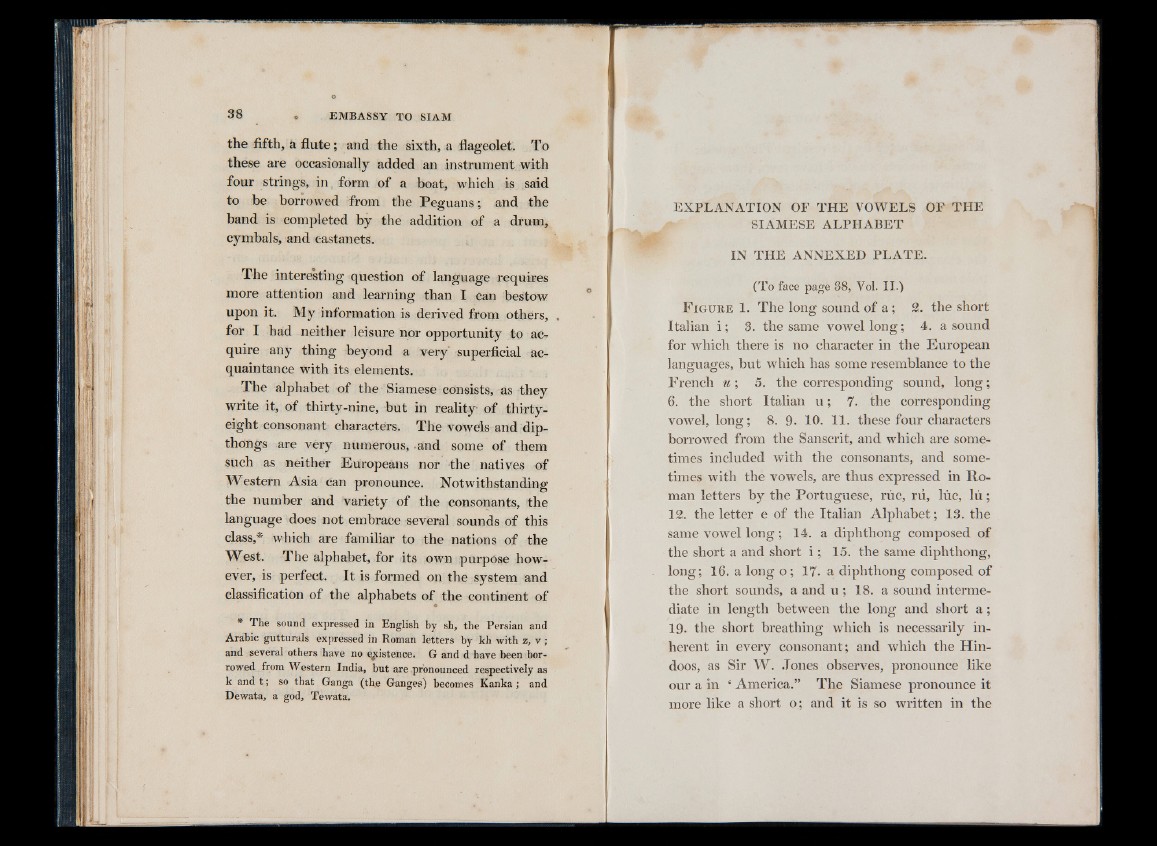
the fifth, a flute; and the sixth, a flageolet. To
these are occasionally added an instrument with
four strings, in form of a boat, which is said
to be borrowed from the Peguans; and the
band is completed by the addition of a drum,
cymbals, and castanets.
The interesting question of language requires
more attention and learning than I can bestow
upon it. My information is derived from others,
for I had neither leisure nor opportunity to acquire
any thing beyond a very' superficial acquaintance
with its elements.
The alphabet of the-Siamese consists, as they
write it, of thirty-nine, but in reality of thirty-
eight consonant characters. The vowels and dip-
thongs are very numerous, .and some of them
such as neither Europeans nor the natives of
Western Asia can pronounce. Notwithstanding
the number and variety of the consonants, the
language does not embrace several sounds of this
class,* which are familiar to the nations of the
West. The alphabet, for its own purpose however,
is perfect. It is formed on the system and
classification of the alphabets of the continent of o
* The sound expressed in English by sh, the Persian and
Arabic gutturals expressed in Roman letters by kh with z, v ;
and several others have no existence. G and d have been borrowed
from Western India, but are pronounced respectively as
k andt; so that Ganga (the Ganges) becomes Kanka; and
Dewata, a god, Tewata.
E X P L A N A T IO N OF T H E VOW E L S OF T H E
S IAM E SE A L P H A B E T
IN T H E A N N E X E D P L A T E .
(T o face page 38, Vol. I I .)
F i g u r e 1 . The long sound of a; 2. the short
Italian i ; 3. the same vowel long; 4. a sound
for which there is no character in the European
languages, but which has some resemblance to the
French u ; 5. the corresponding sound, lo n g ;
6. the short Italian u ; 7. the corresponding
vowel, long; 8. 9- 10. 11. these four characters
borrowed from the Sanscrit, and which are sometimes
included with the consonants, and sometimes
with the vowels, are thus expressed in Roman
letters by the Portuguese, rue, rii, luc, l u ;
12. the letter e of the Italian Alphabet; 13. the
same vowel long ; 14. a diphthong composed of
the short a and short i ; 15. the same diphthong,
long; 16. a long o ; 17. a diphthong composed of
the short sounds, a and u ; 18. a sound intermediate
in length between the long and short a ;
19- the short breathing which is necessarily inherent
in every consonant; and which the Hindoos,
as Sir W. .Tones observes, pronounce like
our a in ‘ America.” The Siamese pronounce it
more like a short o ; and it is so written in the